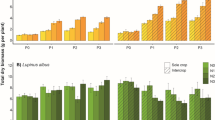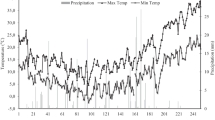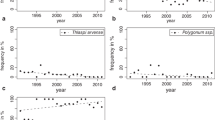Abstract
There is an urgent need for more integrated weed management in commercial cereal production. However, there is gap in the general understanding of crop–weed interactions and the traits contributing to weed suppression by winter cereals. In this research, we measured the above-ground competitive traits crop height, leaf area index and early ground cover and below-ground allelopathic traits by quantification of benzoxazinoid (BX) content in the root zone by HPLC–MS/MS. A partial least squares regression was applied to identify the relative contribution of each trait to explaining the observed variance in weed biomass. The use of three winter cereals, wheat, triticale, and rye enabled us to cover a broad range of weed suppression strategies. For the first time, we were able to demonstrate a positive correlation between BX in plant material and phenoxazinoids in the soil. The highest concentration of BX in the rhizosphere was found at 3–10 cm. Furthermore, differences in crop weed interactions between wheat, rye, and dicotyledonous and monocotyledonous weeds were identified. Interestingly, there was no significant difference between the contribution of any single competitive or allelopathic trait to explain weed biomass. This is valuable information for the establishment of breeding programs for enhanced weed suppression by the cereal crops examined and suggests that an improvement of any of the competitive or allelopathic traits will lead to increased weed suppression. Furthermore, the transfer of traits from rye to wheat via triticale is promising as it may broaden the weed suppressive abilities of wheat.




Similar content being viewed by others
References
Andrew IKS, Storkey J, Sparkes DL (2015) A review of the potential for competitive cereal cultivars as a tool in integrated weed management. Weed Res 55(3):239–248
Aslam F, Khaliq A, Matloob A, Tanveer A, Hussain S, Zahir ZA (2017) Allelopathy in agro-ecosystems: a critical review of wheat allelopathy-concepts and implications
Barzman M, Barberi P, Birch ANE, Boonekamp P, Dachbrodt-Saaydeh S, Graf B, Hommel B, Jensen JE, Kiss J, Kudsk P, Lamichhane JR, Messean A, Moonen A-C, Ratnadass A, Ricci P, Sarah J-L, Sattin M (2015) Eight principles of integrated pest management. Agron Sustain Dev 35(4):1199–1215
Belz RG, Hurle K (2005) Differential exudation of two benzoxazinoids—one of the determining factors for seedling allelopathy of Triticeae species. J Agric Food Chem 53:250–261
Benvenuti S, MacChia M, Miele S (2001) Quantitative analysis of emergence of seedlings from buried weed seeds with increasing soil depth. Weed Sci 49(4):528–535
Bertholdsson NO (2011) Use of multivariate statistics to separate allelopathic and competitive factors influencing weed suppression ability in winter wheat. Weed Res. 51(3):273–283
Bredenberg J, Honkanen E, Virtanen A (1962) The kinetics and mechanism of the decomposition of 2,4.dihydroxy-1,4-benzoxazin-3-one. Acta Chem Scand 16:135–141
Cheng F, Cheng Z (2015) Research progress on the use of plant allelopathy in agriculture and the physiological and ecological mechanisms of allelopathy. Front. Plant Sci 6
Clarke J, Moss S, Orson J (2000) The future for grass weed management in the UK. Pestic Outlook 11(2):59–63
Fujii Y, Qasem J (2013) Allelopathy: current trends and future applications. Springer, New York
Heap I (2017) The international survej of herbicide resistant weeds. www.weedscience.org. Internet
Jabran K, Mahajan G, Sardana V, Chauhan BS (2015) Allelopathy for weed control in agricultural systems. Crop Prot 72:57–65
Jia C, Kudsk P, Mathiassen SK (2006) Joint action of benzoxazinone derivatives and phenolic acids. J Agric Food Chem 54:1049–1057
Krogh SS, Mensz SJM, Nielsen ST, Mortensen AG, Christophersen C, Fomsgaard IS (2006) Fate of benzoxazinone allelochemicals in soil after incorporation of wheat and rye sprouts. J Agric Food Chem 54:1064–1074
Kudsk P, Streibig JC (2003) Herbicides—a two-edged sword. Weed Res 43(2):90–102
Lancashire PD, Bleiholder H, Van den Boom T, Langelueddeke P, Stauss R, Weber E, Witzenberger A (1991) A uniform decimal code for growth stages of crops and weeds. Ann Appl Biol 119:561–601
Lobell DB, Schlenker W, Costa-Roberts J (2011) Climate trends and global crop production since 1980. Science 333(6042):616–620
Macías F, Oliveros-Bastidas A, Marin D, Castellano D, Simonet A, Jmg M (2004) Degradation studies on benzoxazinoids. Soil degradation dynamics of 2, 4-dihydroxy-7-methoxy-(2 H)-1, 4-benzoxazin-3 (4 H)-one (DIMBOA) and its degradation. J Agric Food Chem 52:6402–6413
Macías FA, Marín D, Oliveros-Bastidas A, Castellano D, Simonet AM, Molinillo JMG (2005) Structure-activity relationships (SAR) studies of benzoxazinones, their degradation products and analogues. Phytotoxicity on standard target species (STS). J Agric Food Chem 53:538–548
Macías FA, Marín D, Oliveros-Bastidas A, Castellano D, Simonet AM, Molinillo JMG (2006) Structure-activity relationship (SAR) studies of benzoxazinones, their degradation products, and analogues. Phytotoxicity on problematic weeds Avena fatua L. and Lolium rigidum Gaud. J Agric Food Chem 54:1040–1048
Macias FA, Oliveros-Bastidas A, Marin D, Castellano D, Simonet AM, Molinillo JMG (2005) Degradation studies on benzoxazinoids. Soil degradation dynamics of (2R)-2-O-beta-D-glucopyranosyl-4-hydroxy-(2H)-1,4-benzoxazin-3(4H)-one (DIBOA-Glc) and its degradation products, phytotoxic allelochemicals from gramineae. J Agric Food Chem 53(3):554–561
Molisch H (1937) Der Einfluss einer Pflanze auf die andere-Allelopathie. Fischer, Jena
Oerke E (2006) Crop losses to pests. J Agric Sci 144:31–43
Pedersen HA, Laursen B, Mortensen A, Fomsgaard IS (2011) Bread from common cereal cultivars contains an important array of neglected bioactive benzoxazinoids. Food Chem 127(4):1814–1820
Pérez F, Ormeno-Nunez J (1991) Difference in hydroxamic acid content in roots and root exudates of wheat (Triticum aestivum L.) and rye (Secae cereale L.): Possible role in allelopathy. J Chem Ecol 17(6):1037–1043
R Core Team (2017) R: A language and environment for statistical computing http://www.r-project.org/
Reiss A, Fomsgaard IS, Mathiassen SK, Kudsk P (2018) Weed suppressive traits of winter cereals: Allelopathy and competition. Biochem Syst Ecol 76:35–42
Rice CP, Cai G, Teasdale JR (2012) Concentrations and allelopathic effects of benzoxazinoid compounds in soil treated with rye (Secale cereale) cover crop. J Agric Food Chem 60(18):4471–4479
Sicker D, Frey M, Schulz M, Gierl A (2000) Role of natural benzoxazinones in the survival strategy of plants. Int Rev Cytol A Surv Cell Biol 198:319–346
Steffensen SK, Rinnan A, Mortensen AG, Laursen B, Troiani RM, Noellemeyer EJ, Janovska D, Dusek K, John D-F, Taberner A, Christophersen C, Fomsgaard IS (2011) Variations in the polyphenol content of seeds of field grown Amaranthus genotypes. Food Chem 129(1):131–138
Teasdale JR, Rice CP, Cai G, Mangum RW (2012) Expression of allelopathy in the soil environment: soil concentration and activity of benzoxazinoid compounds released by rye cover crop residue. Plant Ecol 213(12, SI):1893–1905
Tucker CJ, Sellers PJ (1986) Satellite remote-sensing of primary production. Int J Remote Sens 7(11):1395–1416
Voloshchuk N, Knop M, Colby T, Kombrink E, Hennig L, Hofmann D, Sicker D, Gryganski A, Schulz M (2007) How Doratomyces stemonitis copes with benzoxazolin-2(3H)-one (BOA), its derivatives and detoxification products. Chemoecology 17(1):1–12
Wilkes MA, Marshall DR, Copeland L (1999) Hydroxamic acids in cereal roots inhibit the growth of take-all. Soil Biol Biochem 31(13):1831–1836
Worthington M, Reberg-Horton SC, Brown-Guedira G, Jordan D, Weisz R, Murphy JP (2014) Relative contributions of allelopathy and competitive traits to the weed suppressive ability of winter wheat lines against Italian ryegrass. Crop Sci 55(1):57–64
Wu H, Haig T, Pratley J, Lemerle D, An M (2000a) Distribution and exudation of allelochemicals in wheat Triticum aestivum. J Chem Ecol 26(9):2141–2153
Wu H, Haig T, Pratley J, Lemerle D, An M (2001) Allelochemicals in wheat (Triticum aestivum L.): production and exudation of 2,4-dihydroxy-7-methoxy-1,4-benzoxazin-3-one. J Chem Ecol 27(8):1691–1700
Wu H, Pratley J, Lemerle D, Haig T (2000b) Evaluation of seedling allelopathy in 453 wheat (Triticum aestivum) accessions against annual ryegrass (Lolium rigidum) by the equal-compartment-agar method. Aust J Agric Res 51(7):937–944
Zeng RS (2014) Allelopathy—the solution is indirect. J Chem Ecol 40(6):515–516
Zerner MC, Rebetzke GJ, Gill GS (2016) Genotypic stability of weed competitive ability for bread wheat (Triticum aestivum) genotypes in multiple environments. Crop Pasture Sci 67(7):695–702
Acknowledgements
Thanks to Sejet Planteforædling, Jens Bagge and Søren Banke providing the replicate experiments in Middelfart. Furthermore, thanks to KWS Scandinavian, Nordic Seed, Ragt and Sejet Planteforædling for seed donations of their respective cultivars. We also greatly acknowledge Eugene J. Driessen, Karen B. Heinager, Christian A.S. Nielsen, Betina A. Bendtsen and Jakob Sørensen for their help with field work and sampling.
Author information
Authors and Affiliations
Corresponding author
Additional information
Communicated by Marko Rohlfs.
Rights and permissions
About this article
Cite this article
Reiss, A., Fomsgaard, I.S., Mathiassen, S.K. et al. Weed suppression by winter cereals: relative contribution of competition for resources and allelopathy. Chemoecology 28, 109–121 (2018). https://doi.org/10.1007/s00049-018-0262-8
Received:
Accepted:
Published:
Issue Date:
DOI: https://doi.org/10.1007/s00049-018-0262-8




